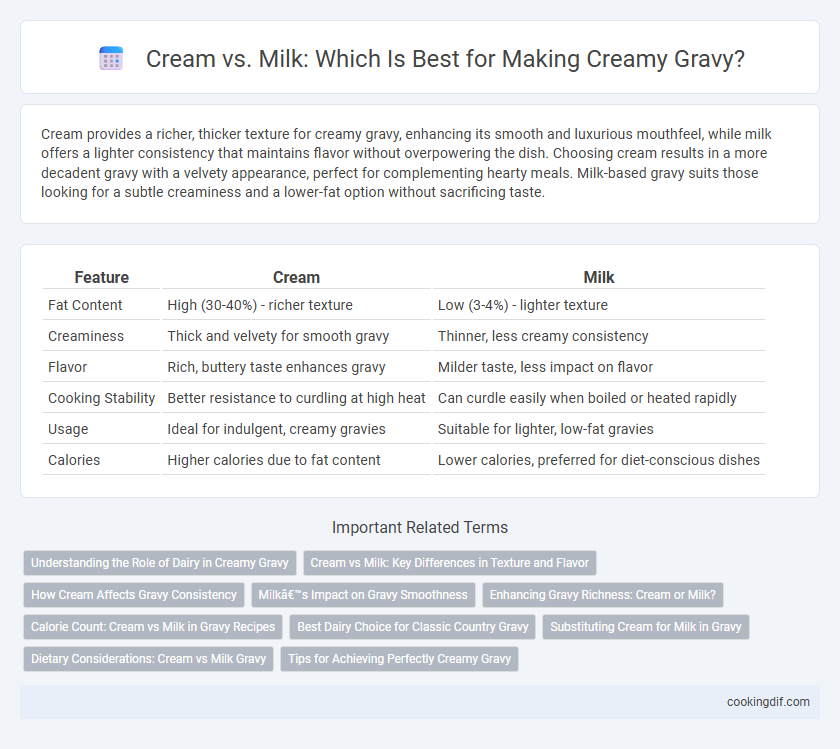Cream provides a richer, thicker texture for creamy gravy, enhancing its smooth and luxurious mouthfeel, while milk offers a lighter consistency that maintains flavor without overpowering the dish. Choosing cream results in a more decadent gravy with a velvety appearance, perfect for complementing hearty meals. Milk-based gravy suits those looking for a subtle creaminess and a lower-fat option without sacrificing taste.
Table of Comparison
| Feature | Cream | Milk |
|---|---|---|
| Fat Content | High (30-40%) - richer texture | Low (3-4%) - lighter texture |
| Creaminess | Thick and velvety for smooth gravy | Thinner, less creamy consistency |
| Flavor | Rich, buttery taste enhances gravy | Milder taste, less impact on flavor |
| Cooking Stability | Better resistance to curdling at high heat | Can curdle easily when boiled or heated rapidly |
| Usage | Ideal for indulgent, creamy gravies | Suitable for lighter, low-fat gravies |
| Calories | Higher calories due to fat content | Lower calories, preferred for diet-conscious dishes |
Understanding the Role of Dairy in Creamy Gravy
Cream provides a higher fat content than milk, which results in a richer, silkier texture ideal for creamy gravy. Milk, with its lower fat percentage, creates a thinner consistency and a milder flavor profile. Selecting cream enhances the body and smoothness of the gravy, making it more indulgent and satisfying.
Cream vs Milk: Key Differences in Texture and Flavor
Cream provides a richer, thicker texture and a more indulgent flavor in gravy compared to milk, which results in a lighter, thinner consistency. The higher fat content in cream enhances the mouthfeel and creates a velvety smooth gravy, while milk contributes a milder taste and a slightly thinner texture. Choosing between cream and milk for gravy depends on the desired richness and consistency, with cream delivering a luxuriously creamy finish and milk offering a more subtle, lighter option.
How Cream Affects Gravy Consistency
Cream enhances gravy consistency by adding a rich, velvety texture and thicker body due to its higher fat content compared to milk. The fat in cream emulsifies with the liquids and starches, creating a smooth, luscious gravy that clings well to dishes. Using cream instead of milk results in a more decadent and stable gravy with improved mouthfeel and gloss.
Milk’s Impact on Gravy Smoothness
Milk enhances gravy smoothness by providing a lighter texture compared to cream, which can sometimes make the gravy overly rich or heavy. The lower fat content in milk allows for easier blending with roux-based thickening agents, resulting in a velvety consistency without compromising the gravy's flavor balance. Using whole milk or 2% milk optimizes creaminess while maintaining a smooth, pourable texture that complements both savory and delicate dishes.
Enhancing Gravy Richness: Cream or Milk?
Cream significantly enhances gravy richness due to its higher fat content, which creates a smoother, velvety texture and deeper mouthfeel compared to milk. Milk, with lower fat, yields a lighter gravy but may require additional thickening agents to achieve desired consistency. Choosing cream over milk results in a more indulgent gravy that coats dishes thoroughly and intensifies flavor profiles.
Calorie Count: Cream vs Milk in Gravy Recipes
Using cream in gravy significantly increases the calorie count due to its higher fat content, averaging around 50 calories per tablespoon compared to whole milk's 9 calories. Milk provides a lighter option with fewer calories, making it suitable for those managing their caloric intake while still achieving a creamy texture. Choosing between cream and milk directly impacts the richness and calorie density of gravy recipes.
Best Dairy Choice for Classic Country Gravy
Heavy cream is the best dairy choice for classic country gravy, providing rich texture and a velvety mouthfeel that milk cannot match. Whole milk creates a thinner gravy with less body, lacking the luscious thickness that cream naturally imparts. For authentic creaminess and deep flavor, heavy cream enhances the gravy's consistency and taste, making it ideal for traditional Southern recipes.
Substituting Cream for Milk in Gravy
Substituting cream for milk in gravy significantly enhances the texture and richness, creating a thicker, silkier sauce ideal for savory dishes. Cream's higher fat content compared to milk contributes to a more velvety consistency and deeper flavor profile, making it a preferred choice for indulgent, creamy gravies. When using cream as a substitute, adjusting the amount slightly can prevent an overly heavy texture while maintaining the desired creaminess.
Dietary Considerations: Cream vs Milk Gravy
Cream-based gravy offers a richer, higher-calorie option with more fat, beneficial for those seeking extra energy or flavor intensity, but may be unsuitable for lactose-intolerant or low-fat diet individuals. Milk-based gravy provides a lighter alternative with fewer calories and less saturated fat, making it preferable for heart-healthy diets and those managing weight. Choosing between cream and milk for gravy depends on dietary needs such as caloric intake, fat content, and lactose sensitivity.
Tips for Achieving Perfectly Creamy Gravy
For perfectly creamy gravy, using heavy cream instead of milk yields a richer, smoother texture due to its higher fat content. When using milk, opt for whole milk and thicken the gravy gradually with a roux or cornstarch slurry to prevent curdling. Whisk continuously over medium heat and avoid boiling to maintain a velvety consistency.
Cream vs Milk for creamy gravy Infographic

 cookingdif.com
cookingdif.com